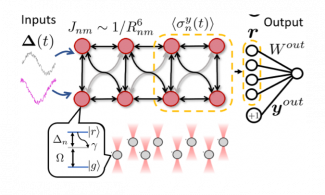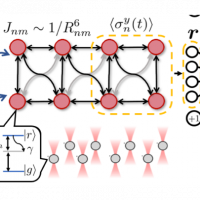News
Quantum computing promises to enhance machine learning algorithms. However, implementing these advantages often relies on either fault-tolerant quantum computers not yet available, or on decoherence-limited, variational quantum circuits which may experience training bottlenecks. Thus, currently available noisy intermediate-scale quantum (NISQ) devices thwart quantum advantages in machine learning algorithms.
Recently, quantum machine learning architectures have emerged inspired by models for computation in the brain. These brain-inspired algorithms are motivated by the inherent robustness to noise in brain-like computation, and by the possibility to use the analogue dynamics of controllable, many-body quantum systems for computation without relying on as-of-yet elusive “universal quantum computers.”In particular, we propose a quantum version of a recurrent neural network, a well-known model for neural circuits in the brain, which makes use of the natural Hamiltonian dynamics of an ensemble of interacting spin-1/2 particles as a means for computation. We show that a Rydberg reservoir is capable of replicating the learning of several cognitive tasks such as multitasking, decision-making, and long-term memory by taking advantage of the key features of this platform (Araiza Bravo R, Najafi K, Gao X, Yelin SF, “Quantum reservoir computing using arrays of Rydberg atoms.” PRX Quantum 3(3):030325 (2022)), also featured in New Scientist magazine.
One key element yet to be added to QNC is the characterization of the requisite dynamics for universal quantum neuromorphic computation. A simple mathematical model for a neuron that is the building block of various machine learning architectures is the “perceptron.” We introduce a quantum perceptron (QP) based on the analog dynamics of interacting qubits with tunable coupling constants. We can demonstrate the effectiveness of QPs by applying them to numerous quantum problems, including calculating the inner products between quantum states, entanglement witnessing, and quantum metrology. (Araiza Bravo R, Najafi K, Patti TL, Gao X, Yelin SF, “Universal Quantum Perceptrons for Quantum Machine Learning,” arXiv:2211.07075)

Figure: (Upper part) Quantum neural network made from Rydberg atoms. Here, we depict interactions between nearest and next-nearest neighbors. However, each neuron interacts with all others in the chain with a distance R_nm-dependent strength J_nm. This can be experimentally modeled using a “Rydberg array” (as found in other CUA research), consisting of atoms in local traps (lower part).
News type:
